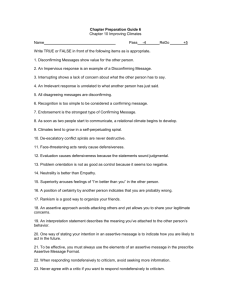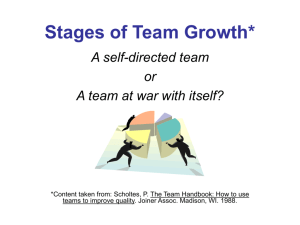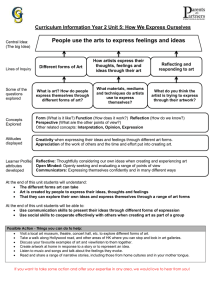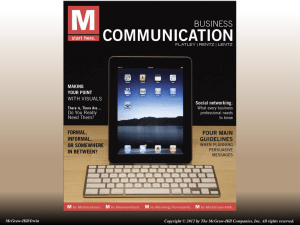Improving Interpersonal Relationships2
advertisement
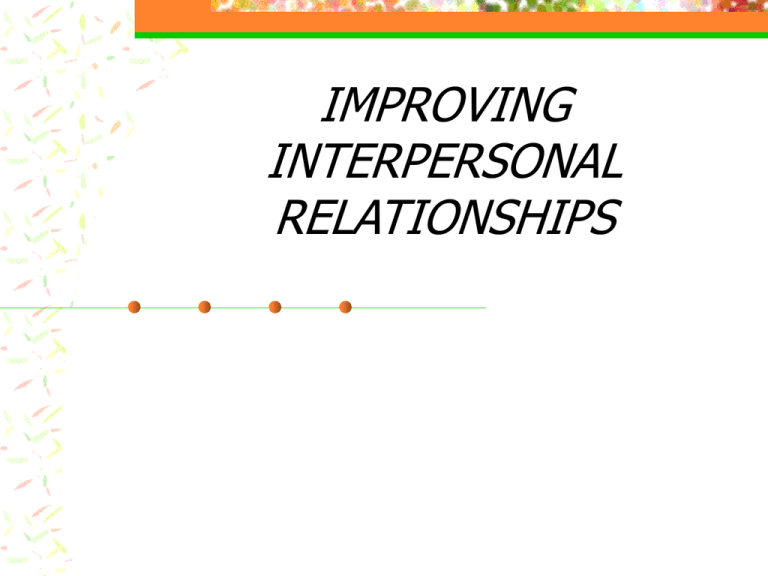
IMPROVING INTERPERSONAL RELATIONSHIPS Communication Climate The emotional feelings that are present when people interact with one another Communication climates are metaphors for the feelings we have when interacting with others Possible relational climates: -stormy -cold -sunny -warm How is communication climate determined? By how communicators speak and act toward one another By how much communicators feel that they are valued by the other person The way another person treats us is often an indicator for how they feel toward us We interpret other’s behaviors in order to determine how important we are to them Confirming responses Messages that tell you that you are valued by the other person Examples of confirming messages: “you matter to me” “you are special” Confirming messages may be displayed verbally or nonverbally Three types of confirming messages Recognition- showing recognition of another person’s presence Acknowledgment- to recognize and validate another’s ideas and feelings Endorsement- recognizing another’s ideas and feelings and showing agreement for them. Disconfirming responses Messages that deny the values of another person May take the form of disagreeing with or ignoring another person’s message How Do Communication Climates Develop? Climates begin as soon as two people begin to communicate The type of messages sent will determine if the climate will be good or bad Verbal and nonverbal messages contribute to the feel of the climate They develop according to communicators responses to one another Self-perpetuating Spirals A spiral takes place when communicators reciprocate and build upon the messages that are sent to one another Each person’s message reinforces the other’s message Communicators build on one another’s messages There are positive and negative spirals Two types of conflict spirals Escalatory conflict spirals- one attack leads to another attack, and continues to build De-escalatory conflict spirals- when communicators decrease amount of involvement with communication by continued withdraw The Gibb Categories for Defensive and Supportive Behaviors list of six pairs of contrasting messages that may either lead to confirming or disconfirming messages Using confirming messages and avoiding disconfirming messages encourages positive relationships Gibb’s six pairs of Defensive and Supportive behaviors: Defensive Evaluation Control Strategy Neutrality Superiority Certainty vs. vs. vs. vs. vs. vs. Supportive Description Problem Orientation Spontaneity Empathy Equality Provisionalism Evaluation vs. Description Evaluative Communication statements that come across as judgmental Often involve an accusatory tone “you” statements Put the other person on the defense Descriptive communication focuses on the thoughts and feelings of the speaker instead of judging the listener Describe how the other person’s behavior has effected him or her, rather than just judging it Often involve “I” statements Control vs. Problem Orientation Control- when sender tries to impose a solution on the receiver with little regard of how that person feels Problem orientation- involves both communicators seeking a solution that is equally satisfying Strategy vs. Spontaneity Strategy- involves the use of manipulation in order to get someone to behave a certain way Spontaneity- the use of honesty to get others to behave a certain way Neutrality vs. Empathy Neutrality- a neutral attitude shows a lack of concern for the other Empathy- showing an understanding for what the other person is going through Superiority vs. Equality Superiority- when people act as is they are better than others Equality- when people behave as though they are equal to everyone else Certainty vs. Provisionalism Certainty- messages that tell the receiver that the sender’s mind is already made up -not open to suggestion Provisionalism- willing to acknowledge other points of view even if they feel they have already made up their mind - involves keeping an open mind ASSERTIVE BEHAVIOR Enables an individual to act in his or her best interests without denying or infringing upon the rights of others Allows people to speak their minds without hurting or threatening others Allows people to express anger or disappointment without acting aggressively Four characteristics of assertive communicators 1. They are open about their feelings 2. They are not anxious, they deal with stressful situations calmly 3. They are contentious, they stand up and argue for their rights, even if this might entail a certain disagreement or conflict 4. They are not intimidated and are not easily persuaded by others PRINCIPLES FOR INCREASING ASSERTIVENESS Analyze the assertive behavior of others Analyze your own behaviors Record your behaviors Rehearse assertive behaviors Act on it, respond assertively when given the chance Five characteristics of an assertive message 1. Behavioral description 2. Your interpretation of the other’s behavior 3. A description of your feelings 4. A description of the consequences 5. A statement of your intentions CONFLICT “Expressed struggle between at least two interdependent parties who perceive incompatible goals, scarce rewards, and interference from the other parties in achieving their goals.” Expressed struggle… Showing unhappiness or disappointment about a situation verbally or nonverbally Both parties must be aware that a conflict exists in order to be in conflict Perceived incompatible goals… Conflicts usually appear to be win-lose. Those in conflict often assume that only one person can win ( so he or she fights to be the winner) Although conflicts may appear to be win-lose there is often a win-win solution available Perceived scarce rewards… Conflicts usually come about because partners believe there isn’t enough of something to go around. (i.e. money, food, love, jobs, time, etc.) Interdependence In one way or another those in conflict are dependent upon each other for something If both parties did not need one another they would not be motivated to pursue the conflict Three types of conflict WIN-LOSE- one person wins the battle and one person looses (one party leaves satisfied, while the other leaves dissatisfied) LOSE-LOSE- both parties lose (both parties leave with a feeling of dissatisfaction) Compromise- a type of lose-lose conflict, both parties give in and leave dissatisfied WIN-WIN-both parties win (both parties leave with a feeling of satisfaction) STEPS IN CREATEING A WIN-WIN CONFLICT 1. Identify your problem and unmet needs 2. Set a specific time to deal with conflict (one that puts both parties in a positive climate) 3. Describe problem and needs 4. Check back with other, in order to ensure understanding 5. Ask other what his or her needs are 6. Paraphrase to make sure you understood 7. Negotiate a solution 8. Follow up on solution that was decided upon NEGOTIATE A SOLUTION 1. Identify and define conflict 2. Generate a number of possible solutions together 3. Evaluate the alternative solutions together 4. Decide on the best solutions together IN CONCLUSION WE CAN ALL BE BETTER AT DEALING WITH CONFLICT WITH A LITTLE KNOWLEDGE AND A LOT OF PRACTICE
